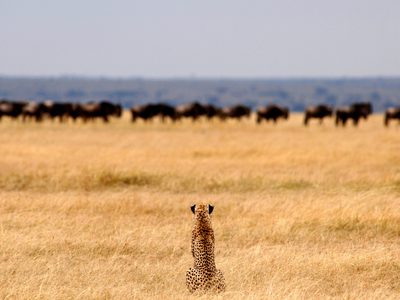
Potentially lethal wildlife. Flights in motorhome-sized aircraft. An unfamiliar country. It’s fair to say that I had my reservations when it came to embarking on a first-time safari – it meant stepping firmly out of my comfort zone.
My feelings were of excitement and apprehension in equal measure. While I was keen to see majestic animals in their natural habitat that I’d only ever seen in photos or a zoo, the idea of cruising around in an open-sided 4x4 and sleeping under canvas with prowling predators and huge beasts roaming outside seemed preposterous, going against every survival instinct I possessed. Yet, as with many situations involving the unknown, any fears I had were ultimately unfounded.
The location for my safari debut? Kenya. Arguably the world’s best wildlife destination, I’d been told there was no better place for sightings and that if I couldn’t find animals here, I never would. This point was proven almost immediately – on my light aircraft journey from the country’s capital, Nairobi, to the magnificent Masai Mara.
Arriving at the Mara
Flying on the fun-size aeroplanes that perform domestic Kenyan flights is an experience in itself. It’s akin to climbing into a 12-person people carrier with wings – Cessna didn’t name them ‘Caravans’ for nothing – with mum and dad (aka the pilot and co-pilot) sitting fully accessible up front. It was immediately clear to see why the baggage allowance was 15kg in soft-sided bags – the aircraft appeared to weigh little more than this itself and all bags were squeezed into small compartments of varying sizes under the cabin.
I found these short trips highly entertaining and relished the fantastic views from the large windows, enjoying the touch-downs en route to destinations to drop off and pick up other passengers. After an unusually bumpy (and most amusing) landing on my first such stop-off, having already been delighted to witness dozens of zebras, wildebeest and even the odd giraffe from the air, I had a pinch-me moment when I spotted at the end of the runway (read ‘dirt airstrip’) a herd of elephants shading themselves under the trees. Now that’s something you don’t see at Heathrow.
Feeling fortunate to have already ticked off one of the Big Five, I was keen to search for more of the same. Yet on the game drive from the airstrip to my accommodation, I was surprised at how thrilling it was to glimpse some of Africa’s more compact wildlife, such as rainbowlike reptiles, gaudy guineafowl and – my favourite – the dinky dik-dik, the world’s smallest (and cutest) antelope. Even common birdlife was a treat for the peepers, particularly the superb starling, which certainly lives up to its name.
Wondering when to go? Take a look at Far and Wild's guides: Best Time To Visit Kenya and When to visit the Masai Mara: best time for safari
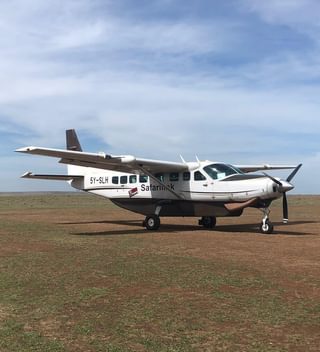
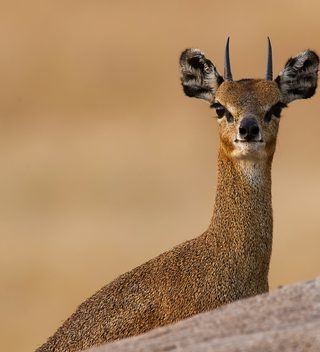
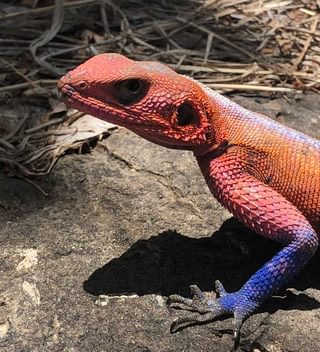
Accommodation
On arriving at our remote lodge in the Mara, I immediately realised that my tent wasn’t as envisaged – a flimsy shelter with no mod cons. No, we were talking glamping accommodation on the grandest of scales, made from robust canvas that felt almost like a permanent structure. With proper beds and bedding, space to hang your clothes and fully-functioning bathrooms boasting towels and toiletries, some camps are as impressive as their surrounding, breathtaking landscapes – which I found were best viewed from the modesty-concealing outdoor showers offered at many, often looking out over stunning vistas, active waterholes or both. Those less inclined to perform their ablutions al fresco can use the indoor facilities, which may prevent the local baboon troop from nabbing your shampoo bottle while you bathe, but this also means you miss out on a liberating escapade that immerses you in the authentic safari experience. Some lodges even provide a handy hairdryer.
Rooms at most camps contain a safe for storing valuables, plus either a reassuring air horn or walkie-talkie, so you can sleep easy knowing that someone will rush to your aid should the need arise. Where required, protective mozzie nets are draped over the beds, which are turned down and sometimes enhanced with a hot water bottle while you’re enjoying a delicious dinner. After dark, guests are walked safely back to their rooms by attentive staff, who are generally armed with a spear or suchlike.
As an aside, don’t expect to see a menu at evening mealtimes – Kenyan camps normally serve fixed courses, which your server will detail beforehand. Only guests with dietary requirements receive something different from other diners. Being a little fussy with certain cuisine, I was unsure how I’d get on with this arrangement, yet even the food that I’d never normally choose to eat was genuinely divine.
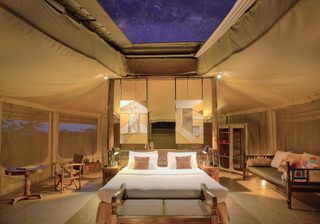
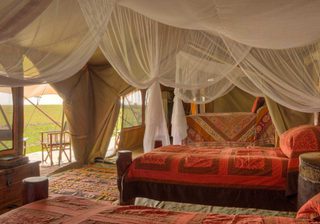
Game Drives
While food, flights and facilities are vital aspects of any trip, a safari in Kenya is, of course, first and foremost about the wildlife. Game drives usually take place twice daily – once in the early morning and again in the late afternoon or early evening. As I set off on my first official game drive to explore the world-renowned Masai Mara, I can’t deny that I was filled with a sense of vulnerability. My friendly and informative guide attempted to put my mind at ease, explaining that animals see the 4x4 vehicle as a large entity that’s part of the landscape and ignore it, as they would a tree. Any further worries went straight out of the non-existent window as we trundled along and I caught sight of dazzling dragonflies swirling, weaver bird nests hanging like baubles from trees and wandering warthogs gallivanting with their tails high in the air. We passed groups of gazelle, herds of buffalo … and before long, my guide slowed to a snail’s pace and simply said: ‘Lion.’ He had spotted a large male and made to pull up some way ahead of it. Both petrified and captivated, I watched – hardly daring the breathe – as it slowly meandered right up to the vehicle. It then stalked close behind it, swishing its tail as it went and hitting the back of the truck, making me jump almost out of it.
Sightings such as this were by no means isolated and the following day offered the most mind-blowing moment of my entire trip, when we witnessed a female cheetah – the icing on the cake being that with her was her adorable adolescent cub. Even better, after several minutes of patiently waiting, we observed the mother run at full pelt in pursuit of a Thomson’s gazelle. Sadly, she failed to catch her quarry, but this was nevertheless an exhilarating sight to behold.
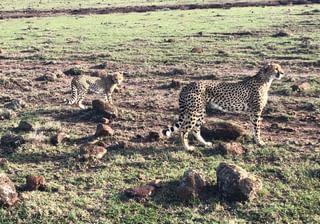

Sundowners
The best non-wildlife-related discovery for a first-time safari-goer is undoubtedly the obligatory sundowner – as the name suggests, this ritual entails a refreshing drink (usually alcoholic) served as the sun slips below the horizon. As you round off your day’s adventures, your guide will pause your game drive to stop in a spot ideal for celebrating a great day in the African bush. My favourite and most memorable sundowner was when we’d settled under a large tree, where my guide and his companions had lit a warming fire. The last of the sun’s rays were long gone, it was rapidly cooling down and we were now sitting in the dark, marvelling at the lack of light pollution and insanely starry sky above. As I took another sip of my tasty tipple, I became aware that the fire wasn’t the only thing that was roaring. At least two highly vocal lions were nearby … and getting closer. As ever, our guide reassured us that there was no reason to be concerned – the big cats were further away than they sounded. These guys truly know their stuff and I trusted their judgement implicitly. Back in the vehicle en route home to our lodge, with the help of our guide’s low-intensity flashlight, we later located two male lions and watched for some time as one drank enthusiastically from a watering hole.
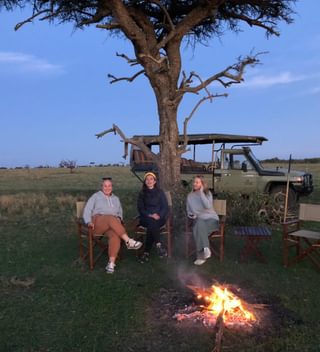
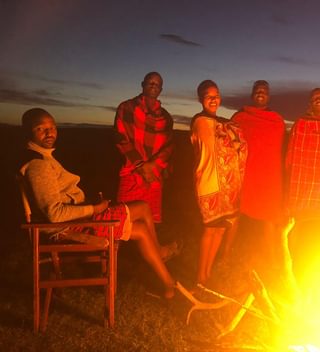
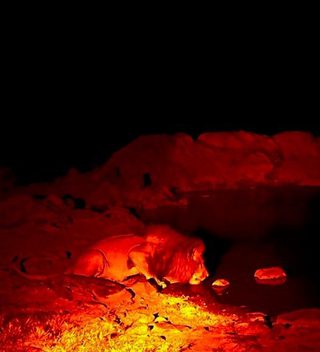
Hot Air Ballooning
While seeing Kenya’s array of wonderful wildlife from the ground is undeniably riveting, seeing it from above – from a hot air balloon – is quite literally on another level. A sunrise balloon safari begins with a ridiculously early wakeup call (usually around 4.30am) and ends with a lavish bush breakfast that more than makes up for any lack of sleep. While you’re sure to witness a good variety of wildlife, as you float gently over the treetops it dawns on you that this serene activity is about more than just the animals below. It’s the joy of having a bird’s eye view of Kenya’s vast plains – any wildlife is merely a bonus. This unique and unforgettable experience lasts between 45 minutes and one hour, with the landing being perhaps the most amusing part, as the balloon’s basket tends to tip over … along with its occupants.
Want to learn more? Hot air ballooning in the Masai Mara
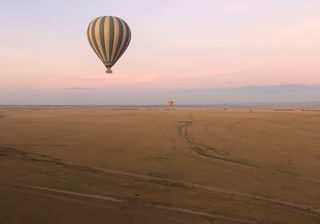
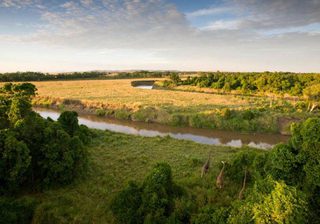
Walking Safari
The final safari of my trip was on foot. A walking safari is unlikely to appeal to every traveller – including me. Why would any sane person willingly venture off the beaten track to be so exposed to Africa’s teeming wildlife? Signing the mandatory liability waiver, I wondered what I was letting myself in for; no sooner had I embarked on this ambling adventure than I knew I was in safe hands, however. Our group of four were flanked by our guide, five spear-wielding Maasai and a ranger armed with a gun, all of whom were highly trained in animal behaviour. We were advised on how to react in different animal-altercation scenarios, before learning about the fascinating landscape, plants and birdlife. Having identified multiple animal tracks and droppings, we heard dozens of vervet monkeys in the tall trees screeching alarm calls, indicating that a leopard was nearby. Sadly, we failed to see this elusive big cat, though we did pass several giraffe, plus countless zebra and gazelle. The highlight of the walk was without a doubt the sight of four noisy hyenas across the plain, whooping and cavorting not far ahead. A little unnerved at this point, I was rightly told that this raucous quartet would ‘give way’ so long as we remained close together. Talk about a walk on the wild side.
The orchestra of insects and neighbouring hippo’s grunts that accompanied my last night in Kenya perfectly summed up my trip overall: slightly surreal, yet unimaginably magical. The safari bug had well and truly bitten.
Fancy a walk on the wild side? Best walking safaris in Africa - The top 11

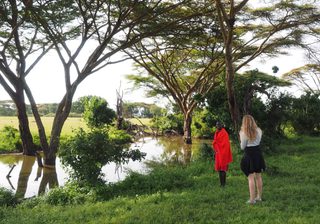
TOP TIPS FOR FIRST-TIME SAFARI-GOERS
Aside from lifelong memories, I took away several pointers from my first Kenyan safari:
- You needn’t dress head-to-toe in khaki. There’s no need, as you’ll be sitting in a vehicle most of the time. Neutral-coloured clothing is nevertheless advisable and it’s best to avoid black, blue, navy and red, as these attract biting insects. White is another no-no – it will get filthy.
- Don’t overpack – you need less than you think. Although the 15kg baggage limit for most light aircraft flights sounds unfeasible, it’s actually plenty for the majority of travellers. Many camps offer a 24-hour laundry service and I’m not exaggerating when I say that at least half the clothes I took away with me returned home unworn.
- Take a soft holdall or similar. Hard suitcases cannot be taken on light aircraft flights.
- Prepare for a windswept look. Whizzing around in an open 4x4 can wreak havoc on your hair and your barnet may never be knot-free again if it’s not tied back or covered with a hat.
- It’s a bumpy ride. Journeys on game drives are far from smooth – and the further back in the vehicle you sit, the bumpier it will be. Women would be wise to bring a sturdy sports bra.
- Take binoculars if you have them. You’ll be glad you did.
- Set your own alarm. When you need to be up early for a game drive or other activity, set your phone to wake you. Lodge staff may call at your room when it is time to leave, rather than when you’d have liked to get up.
- Wifi is often available. Many camps have free wifi in their communal areas, though not all.
- Single-use plastic is banned in Kenya. Any plastic bags or disposable bottles in your luggage will need to be thrown away on arrival.
For more ideas of where to go on your first safari, take a look at our guide.
If you'd like to book a Kenya safari, speak to one of our experts on 01768 603 715 or enquire below.































